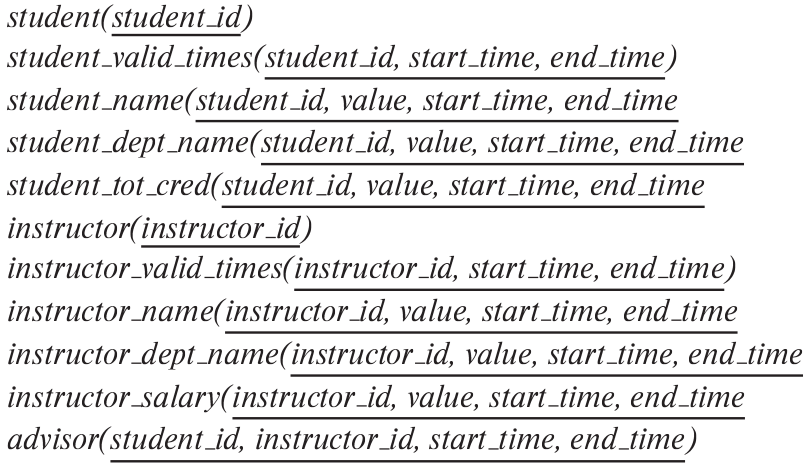6.13
An E-R diagram usually models the state of an enterprise at a point in time. Suppose we wish to track temporal changes, that is, changes to data over time. For example, Zhang may have been a student between September 2015 and May 2019, while Shankar may have had instructor Einstein as advisor from May 2018 to December 2018, and again from June 2019 to January 2020. Similary, attribute values of an entity or relationship, such as title and credits of course, salary, or even name of instructor, and tot_cred of student, can change over time.
One way to model temporal changes is as follows: We define a new data type called valid_time, which is a time interval, or a set of time intervals. We then associate a valid_time attribute with each entity and relationship, recording the time periods during which the entity or relationship is valid. The end time of an interval can be infinity; for example, if Shankar became a student in September 2018, and is still a student, we can represent the end time of the valid_time interval as infinity for the Shankar entity. Similarly, we model attributes that can change over time as a set of values, each with its own valid_time.
Draw an E-R diagram with the student and instructor entities, and the advisor relationship, with the above extensions to track temporal changes.
Convert the E-R diagram discussed above into a set of relations.
It should be clear that the set of relations generated is rather complex, leading to difficulties in tasks such as writing queries in SQL. An alternative approach, which is used more widely, is to ignore temporal changes when designing the E-R model (in particular, temporal changes to attribute values), and to modify the relations generated from the E-R Model to track temporal changes.
- The E-R diagram is shown in Figure 6.106.

The primary key attributes student_id and instructor_id are assumed to be immutable, that is, they are not allowed to change with time. All other attributes are assumed to potentially change with time.
Note that the diagram uses multivalued composite attributes such as valid_times or name, with subattributes such as start_time or value. The value attribute is a subattribute of several attributes such as name, tot_cred and salary, and refers to the name, total credits or salary during a particular interval of time.
- The generated relations are as shown below. Each multivalued attribute has turned into a relation, with the relation name consisting of the original relation name concatenated with the name of the multivalued attribute. The relation corresponding to the entity has only the primary-key attribute, and this is needed to ensure uniqueness.

The primary keys shown are derived directly from the E-R diagram. If we add the additional constraint that time intervals cannot overlap (or even the weaker condition that one start time cannot have two end times), we can remove the end_time from all the above primary keys.